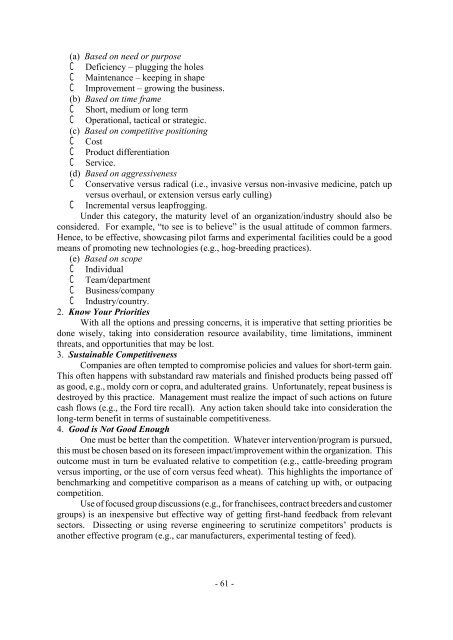Development of Agribusiness Enterprises - Asian Productivity ...
Development of Agribusiness Enterprises - Asian Productivity ...
Development of Agribusiness Enterprises - Asian Productivity ...
You also want an ePaper? Increase the reach of your titles
YUMPU automatically turns print PDFs into web optimized ePapers that Google loves.
(a) Based on need or purpose<br />
C Deficiency – plugging the holes<br />
C Maintenance – keeping in shape<br />
C Improvement – growing the business.<br />
(b) Based on time frame<br />
C Short, medium or long term<br />
C Operational, tactical or strategic.<br />
(c) Based on competitive positioning<br />
C Cost<br />
C Product differentiation<br />
C Service.<br />
(d) Based on aggressiveness<br />
C Conservative versus radical (i.e., invasive versus non-invasive medicine, patch up<br />
versus overhaul, or extension versus early culling)<br />
C Incremental versus leapfrogging.<br />
Under this category, the maturity level <strong>of</strong> an organization/industry should also be<br />
considered. For example, “to see is to believe” is the usual attitude <strong>of</strong> common farmers.<br />
Hence, to be effective, showcasing pilot farms and experimental facilities could be a good<br />
means <strong>of</strong> promoting new technologies (e.g., hog-breeding practices).<br />
(e) Based on scope<br />
C Individual<br />
C Team/department<br />
C Business/company<br />
C Industry/country.<br />
2. Know Your Priorities<br />
With all the options and pressing concerns, it is imperative that setting priorities be<br />
done wisely, taking into consideration resource availability, time limitations, imminent<br />
threats, and opportunities that may be lost.<br />
3. Sustainable Competitiveness<br />
Companies are <strong>of</strong>ten tempted to compromise policies and values for short-term gain.<br />
This <strong>of</strong>ten happens with substandard raw materials and finished products being passed <strong>of</strong>f<br />
as good, e.g., moldy corn or copra, and adulterated grains. Unfortunately, repeat business is<br />
destroyed by this practice. Management must realize the impact <strong>of</strong> such actions on future<br />
cash flows (e.g., the Ford tire recall). Any action taken should take into consideration the<br />
long-term benefit in terms <strong>of</strong> sustainable competitiveness.<br />
4. Good is Not Good Enough<br />
One must be better than the competition. Whatever intervention/program is pursued,<br />
this must be chosen based on its foreseen impact/improvement within the organization. This<br />
outcome must in turn be evaluated relative to competition (e.g., cattle-breeding program<br />
versus importing, or the use <strong>of</strong> corn versus feed wheat). This highlights the importance <strong>of</strong><br />
benchmarking and competitive comparison as a means <strong>of</strong> catching up with, or outpacing<br />
competition.<br />
Use <strong>of</strong> focused group discussions (e.g., for franchisees, contract breeders and customer<br />
groups) is an inexpensive but effective way <strong>of</strong> getting first-hand feedback from relevant<br />
sectors. Dissecting or using reverse engineering to scrutinize competitors’ products is<br />
another effective program (e.g., car manufacturers, experimental testing <strong>of</strong> feed).<br />
- 61 -
















